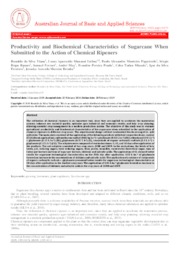Productivity and biochemical characteristics of sugarcane when submitted to the action of chemical ripeners.
Productivity and biochemical characteristics of sugarcane when submitted to the action of chemical ripeners.
Author(s): VIANA, R. da S.; LISBOA, L. A. M.; FIGUEIREDO, P. A. M.; RAMOS, S. B.; FERRARI, S.; MAY, A.; PRADO, E. P.; MIASAKI, C. T.; FERREIRA, I. S.; BRENHA, J. A. M
Summary: Abstract: The utilization of chemical ripeners is an important tool, since they are applied to accelerate the maturation process, enhance raw material quality, optimize agro industrial and economic results, and help crop planning, allowing essential crop management in a modern production system. The objective of this study was to evaluate agricultural productivity and biochemical characteristics of the sugarcane when submitted to the application of chemical ripeners in different crop years. The experimental design utilized randomized blocks arranged in split split plots. The main plots consisted of the application of the following products with their respective doses: control (C) (without application), sulfomethuron-methyl (0.02 kg ha-1) + glyphosate (0.15 L ha-1) (SG), ethephon (0.34 L h-1) + glyphosate (0.15 L ha-1) (EG), glyphosate (0.35 L h-1) (G), compounds of organic carboxylic radicals (1.0 L h-1) + glyphosate (0.15 L h-1) (CG). The subplots were composed of evaluation times: 0, 15, and 30 days after application of the products. The sub-subplots consisted of two crop years, 2008 and 2009. In the evaluations, the levels of brix levels, pol, reducing sugars, total reducing sugars, fiber, purity, humidity, recoverable theoretical sugar, tons of Culms per hectare and tons of sugar per hectare, shikimic and salicylic acids. The application of CG showed better results for sugarcane technological characteristics on the 30th day after application. 0.35 L ha-1 of glyphosate favored an increase in the concentrations of shikimic and salicylic acids. The application of a mixture of compounds of organic carboxylic radicals + glyphosate presented better results for sugarcane technological characteristics at 30 days after application in the studied crop years. The application of 0.35 L ha-1 glyphosate favored an increase in the concentrations of shikimic and salicylic acids in the crop years of 2008 and 2009.
Publication year: 2019
Types of publication: Journal article
Unit: Embrapa Environment
Observation
Some of Embrapa's publications are published as ePub files. To read them, use or download one of the following free software options to your computer or mobile device. Android: Google Play Books; IOS: iBooks; Windows and Linux: Calibre.
Access other publications
Access the Agricultural Research Database (BDPA) to consult Embrapa's full library collection and records.
Visit Embrapa Bookstore to purchase books and other publications sold by Embrapa.

